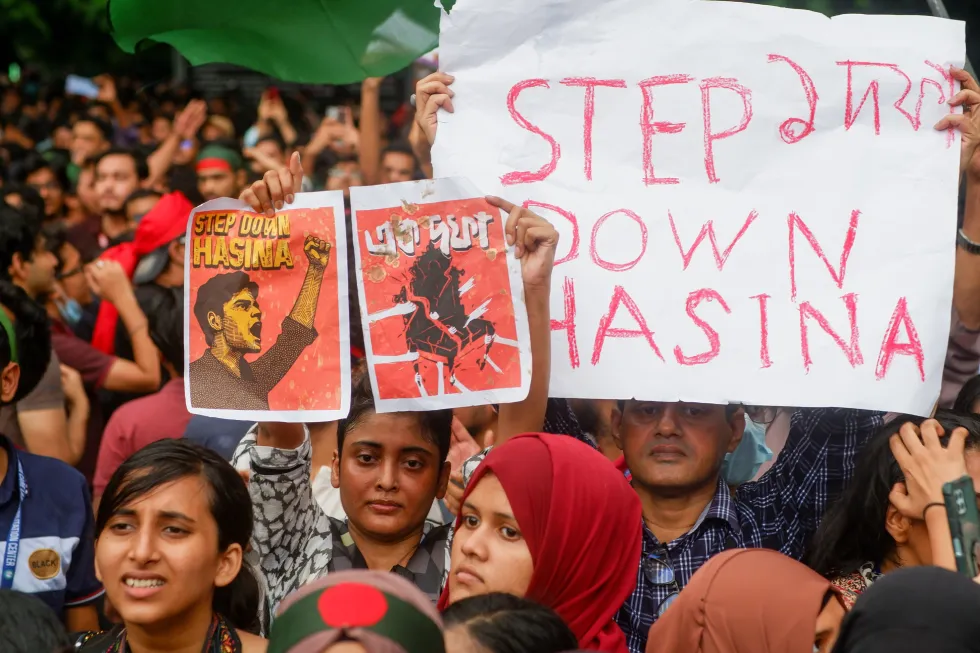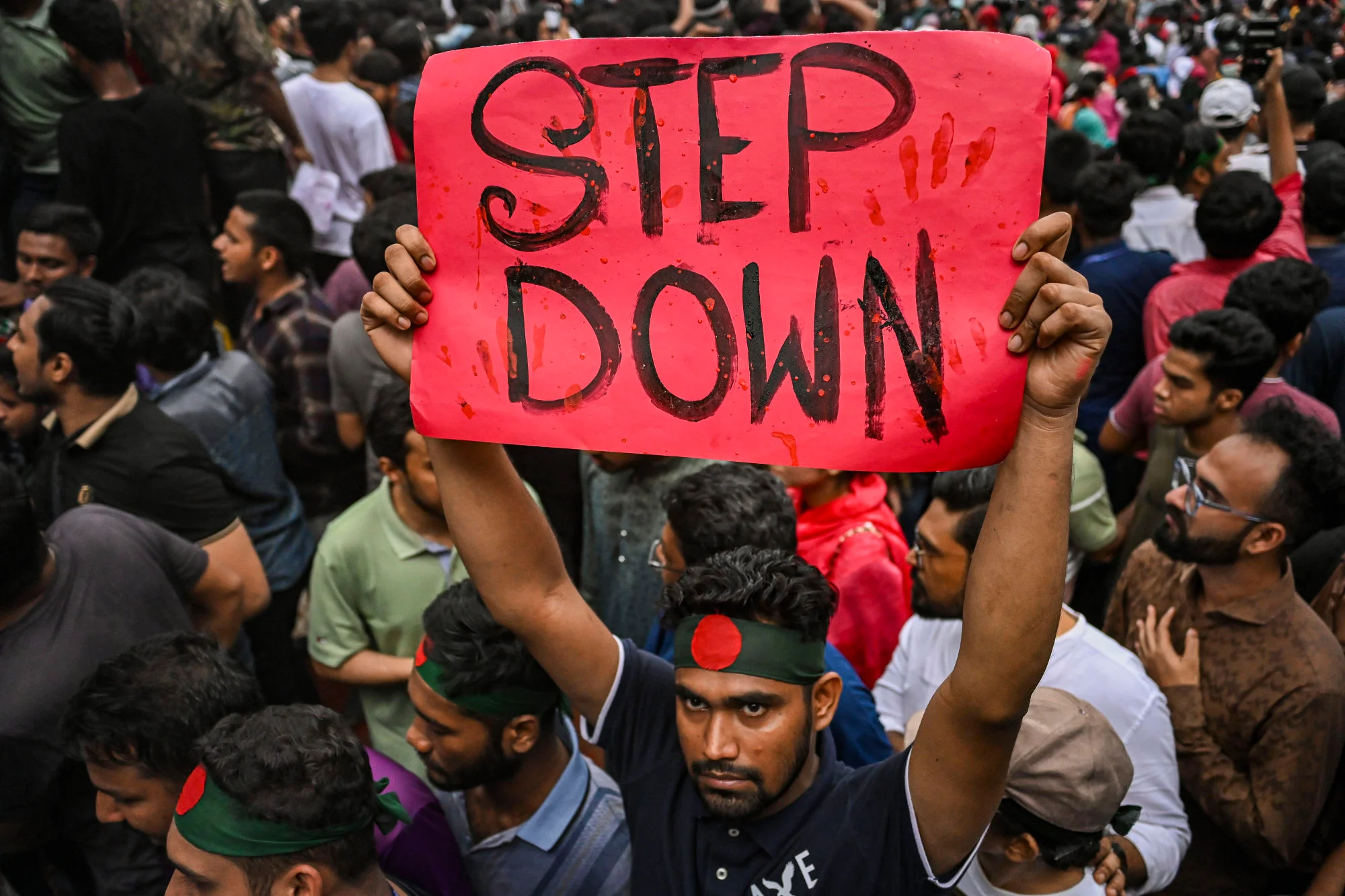The July 2024 Quota Reform Movement: A Nation’s Triumph for Change and Unity
- Mehrin Khan
- Jan 25
- 7 min read
By Mehrin Khan and Manzarul Akhandh
The July 2024 protests that rocked Bangladesh were ignited by long-standing grievances over the country's quota system for civil service jobs. While initially intended to promote inclusivity, the quota system became increasingly controversial, particularly among students and job seekers. These protests, which began in earnest in July, were sparked by demands to reform the system, leading to violent clashes, political upheaval, and the eventual fall of Prime Minister Sheikh Hasina’s government.

Background: The Quota Debate
The roots of the July 2024 protests trace back to 2018 when the Bangladesh government issued a circular abolishing the 56% quota system in public service jobs, following protests from students and job seekers advocating for merit-based recruitment. While the government aimed to create a more meritocratic system, the abolition sparked widespread opposition. The situation escalated on June 5, 2024, when the High Court ruled the government's cancellation of the freedom fighter quota was illegal, reinstating the 30% freedom fighter quota. Despite this, many students continued to protest, seeking further reforms.
July 7: The "Bangla Blockade" Begins
The protests escalated in early July, with students calling for a nationwide blockade of roads and highways on July 7, named the "Bangla Blockade." Protests began in major Dhaka intersections such as Shahbagh, Science Lab, and Mohakhali, with students demanding the abolition of the quota system and the reinstatement of the 2018 circular. On July 6, the protesters announced the "Bangla Blockade," with coordinators like Nahid Hasan warning that they would continue to block key routes if their demands were ignored.
Jahangirnagar University students were at the forefront of these protests, forming human chains and blocking roads, including the Dhaka-Aricha highway, as part of their four-point demands. These included reinstating the 2018 circular, forming a commission to review the quotas, and ensuring a merit-based recruitment system free of corruption. Students from universities across the country, including Dhaka University and Jagannath University, joined the protests, resulting in significant disruptions.

July 10-11: Escalating Clashes
On July 10, the Appellate Division of the Supreme Court imposed a status quo on the quota issue for four weeks. Despite this, protests intensified, with students continuing their sit-ins and highway blockades, even in the face of police obstruction. On July 11, Awami League General Secretary Obaidul Quader condemned the protesters, labeling their actions as unwarranted. Meanwhile, Chhatra League members attacked protesting students, marking a turning point in the violence.
July 12-14: Prime Minister's Remarks Ignite Further Protests
The protests grew fiercer when Prime Minister Sheikh Hasina referred to the protesting students as "children of Razakars" during a press briefing on July 14, further fueling the movement. The term Razakar is highly controversial in Bangladesh. It refers to individuals who collaborated with the Pakistani military during the 1971 Liberation War, which led to the country’s independence. Razakars were part of militia groups that fought against the Bangladeshi independence movement and were accused of committing atrocities, including murder, rape, and other forms of violence against Bengali civilians.
For many Bangladeshis, calling someone a "Razakar" is a deeply insulting charge, as it links them to collaboration with the enemy during the war. Therefore, when Prime Minister Hasina used the term "children of Razakars" to describe the student protesters, it was seen as an attempt to delegitimize their cause by associating them with betrayal and violence from the war era. This rhetoric only intensified the protests, with students organizing a midnight demonstration at Dhaka University. Female students even broke through locks placed on their halls by university authorities to prevent their participation in the protests.
Violent clashes between the students and pro-government Chhatra League members escalated in the following days, and by July 15, attacks on protesters had increased significantly, leaving at least 300 injured. The tensions sparked by the Prime Minister’s comments played a key role in galvanizing the protests, spreading them across the country and intensifying calls for change.

July 16-23: Bloody Clashes and Nationwide Unrest
By July 16, the protests had turned deadly, with clashes between students, police, and pro-government groups resulting in at least six fatalities. On July 19, a nationwide curfew was imposed as violence intensified, and the government deployed the army to maintain control. The internet was also shut down, further isolating Bangladesh from the outside world.
On July 21, the Supreme Court delivered its verdict, largely abolishing the quotas for civil service jobs, leaving 93% of government recruitment open to merit-based applications. However, violence continued, and the crackdown on protests led to widespread casualties, with at least 66 people killed by July 19.
July 24-27: The Aftermath of Violence
As the protests continued, three key student leaders—Asif Mahmud, Abu Baker Majumdar, and Rifat Rashid—were abducted by unknown persons on July 19, only to be released several days later. International organizations, including the UN and Amnesty International, called for an end to the crackdown on students, but violence persisted. On July 27, the government announced a death toll of 147, and the diplomatic community urged accountability for the violence.
July 29-31: The Call for Justice
On July 29, a nationwide "March for Justice" was organized, demanding accountability for the killings, disappearances, and arrests. Protests spread across Dhaka and other cities, with university professors joining the movement. The day of mourning declared by the government was rejected by the student movement, which continued their demonstrations in defiance of the government's actions.
Pictures of Protests from All Across Bangladesh
August 3-5: The "Long March to Dhaka" and the End of Hasina’s Regime
The movement reached its peak on August 3 when the "Long March to Dhaka" was announced, demanding the resignation of Prime Minister Sheikh Hasina. What began as a student-led protest soon saw an unprecedented level of unity across the country, with people from all walks of life—students, workers, teachers, and even ordinary citizens—joining forces. This was not just a fight against the quota system but became a broader call for political change and justice. People from cities, towns, and villages alike began converging on Dhaka, showing that the movement had spread far beyond university campuses and had galvanized the entire nation.
The protests on August 4 became the deadliest of the entire movement. Around 91 people were killed, including 14 police officers, as widespread clashes erupted in Dhaka and at least 21 districts across the country. Major highways were blocked, government offices and ruling party establishments were attacked, and the streets of Dhaka were filled with a sea of protesters demanding an end to what they saw as an oppressive regime.
This nationwide solidarity reached its height on August 5. Despite a curfew and military presence, thousands of students, citizens, and workers from all over the country defied orders and marched toward Dhaka. They stormed the capital, with massive crowds descending on Ganabhaban, the Prime Minister’s residence. The overwhelming show of force led to a dramatic conclusion by afternoon: Prime Minister Sheikh Hasina, unable to quell the protests, handed in her resignation. She fled to India via a military aircraft, marking the collapse of her government.
This moment symbolized the collective power of the people, demonstrating how the entire nation had come together to demand change. What started as a student protest grew into a unified movement, encompassing the voices of millions of Bangladeshis from all corners of the country.
Pictures of One Point Demand -"Step Down Hasina"

Aftermath: The Rise of Dr. Mohammad Yunus as Chief Advisor
In the aftermath of Sheikh Hasina's resignation and the collapse of her government on August 5, 2025, Bangladesh faced a power vacuum. The country, though victorious in its demands for change, was left to rebuild its political institutions and restore order after months of intense protests and violent clashes. The streets were filled with a mixture of celebrations for the fall of the regime and anxiety over the future.
It was during this uncertain time that Dr. Mohammad Yunus, the Nobel Laureate and renowned social entrepreneur, was elected as the Chief Advisor to lead the transitional government. Yunus, who had gained global recognition for his work with microfinance and social business through Grameen Bank, was seen by many as a figure of integrity and trust, someone who could steer Bangladesh out of its crisis and into a more just and equitable future.
Yunus’s appointment was a symbolic move, as he was a person with no direct political affiliations and was widely respected both nationally and internationally. His leadership was expected to be impartial and focused on rebuilding the nation’s fractured political system. In his role, he promised to prioritize national reconciliation, economic reforms, and the establishment of a caretaker government that would oversee free and fair elections in the coming months.
As the first act of his leadership, Yunus helped broker discussions between political parties, civil society, and student organizations to form a national unity government. This government aimed to balance the political landscape and ensure that the country's long-term stability was maintained.
Students' Role in the Restoration of Order
While Dr. Yunus took the reins of leadership, the role of students remained pivotal in the recovery process. In the days following the fall of Hasina’s government, students took it upon themselves to clean up the destruction caused by the violence and the chaos of the protests. Students from various universities, colleges, and schools across the country came together to restore order, symbolizing their ownership over the nation they had fought to transform.
One of the most notable efforts was the cleaning of the National Parliament building, which had been vandalized during the protests. Students, using brooms and gloves, worked tirelessly to clear debris and restore the area to its former state. This act of civic responsibility was a powerful statement of unity and maturity, as the young people of Bangladesh demonstrated that they were not only the driving force behind political change but were also dedicated to rebuilding their nation.
Moreover, students also took responsibility for ensuring smooth traffic movement across Dhaka, with many organizing themselves into groups to direct traffic and maintain order in the bustling city. The chaotic scenes of the past weeks gave way to a sense of peace and restoration as the country began the process of healing.
In these crucial moments of rebuilding, Dr. Yunus’s leadership and the students' efforts to clean and restore their country marked a new beginning for Bangladesh. The fall of the regime had brought immense pain, but it also opened the door for a new, hopeful future under a government that, for the first time in decades, seemed more in tune with the people's demands and needs.
Sources:
Bangla Tribune: Bangla Blockade Details
Dhaka Tribune: Jahangirnagar University Protest
The Daily Star: History of the Quota System in Bangladesh
Al-Jazeera: How Bangladesh’s ‘Gen Z’ protests brought down PM Sheikh Hasina
Write-up by Mehrin Khan and Manzarul Akhand






















Comments